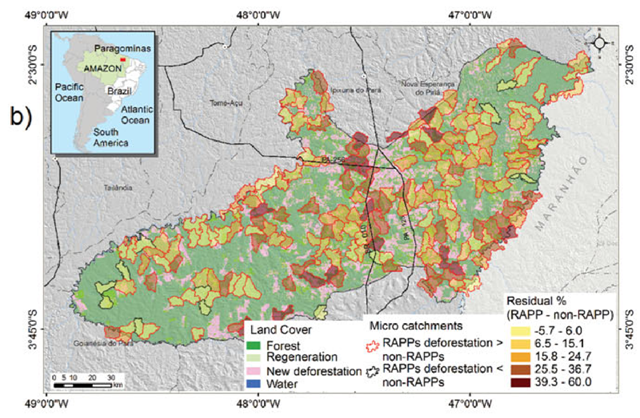Graph of the Day: Deforestation inside and outside riparian protected areas in the Brazilian Amazon, 1988-2010
ABSTRACT: Brazilian environmental law imposes more restrictions on land-use change by private landowners in riparian forests than in non-riparian forest areas, reflecting recognition of their importance for the conservation of biodiversity and key ecosystem services. A 22-year time series of classified Landsat images was used to evaluate deforestation and forest regeneration in riparian permanent preservation areas over the past two decades, focusing on the municipality of Paragominas in the state of Pará in eastern Amazonia. There was no evidence that riparian forests had been more effectively protected than nonriparian forests. Instead, deforestation was found to be comparatively higher inside riparian permanent preservation areas as recently as 2010, indicating a widespread failure of private property owners to comply with environmental legislation. There was no evidence for higher levels of regeneration in riparian zones, although property owners are obliged by law to restore such areas. A number of factors limit improvements in the protection and restoration of riparian forests. These include limited awareness of environmental compliance requirements, the need for improved technical capacity in mapping the distribution and extent of riparian forests and the boundaries of private properties, and improved access to the financial resources and technical capacity needed to support restoration projects. We found no evidence that riparian forests have been more effectively protected than non-riparian forests in Paragominas. The percentage of forest loss was, in fact, comparatively higher inside than outside RAPPs as recently as 2010, indicating a widespread lack of compliance with environmental legislation. This failure of compliance was further illustrated by a lack of evidence for higher levels of regeneration in riparian zones, where, according to the Brazilian Constitution (Article 225, §3°), property owners have been obliged since 1988 to restore areas that have been cleared illegally.
The legal protection given to riparian forests by Brazilian environmental law has not been sufficient to prevent them from being deforested in Paragominas, a flagship municipality for land-use sustainability in the Brazilian Amazon. By contrast, we found that deforestation inside riparian APPs was greater than deforestation outside RAPPs, even as recently as 2010. We also found that regeneration of deforested RAPP areas has fallen far short of what is needed for private properties to comply with legal requirements (whether prior to or after the revision of the federal Forest Code). Priority for restoration action must focus on larger properties because they account for most of the deforestation within RAPPs in Paragominas and across much of the Amazon. However, smaller properties, which include some of the poorest and most vulnerable people in the region, exhibit the highest relative rates of deforestation in RAPPs (deforestation as a proportion of total RAPP area), also require much greater attention, including the provision economic incentives and technical support on where and how to restore.
A 22 year assessment of deforestation and restoration in riparian forests in the eastern Brazilian Amazon [pdf]
